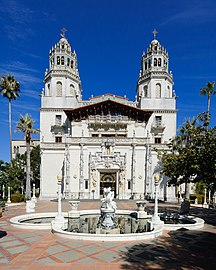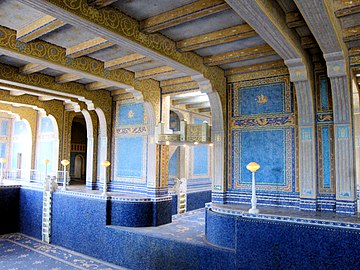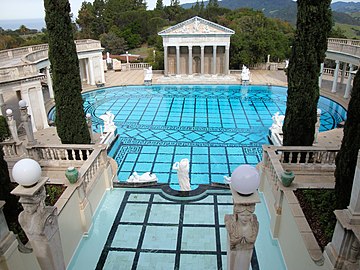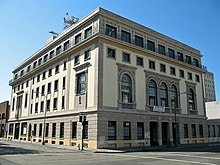Julia Morgan
Julia Morgan ( January 20, 1872 - February 2 , 1957 ) was an American architect . During her long and prolific career, she designed more than 700 buildings in California. She is best known for her work on Hearst Castle in San Simeon , California.
Morgan was the first woman accepted into the architecture program at the École Nationale Supérieure des Beaux-Arts and the first female architect to be licensed in California. She designed many buildings for institutions serving women and girls, including YWCA buildings and buildings for Mills College .
Morgan was a follower of the Arts and Crafts Movement and used the products of various California pottery manufacturers to decorate her buildings. She tried to reconcile classic and craftsmanship, science and innovation, formalism and whimsy. She is considered a representative of eclecticism .
Julia Morgan became the first woman to posthumously receive the American Institute of Architects Gold Medal in 2014 .
origin and family
Morgan's father, Charles Bill Morgan, came from a prominent East Coast family. He studied mining engineering and went to San Francisco in 1867 to speculate in mines and oil. The next year he returned to marry Eliza Woodland Parmelee, the favorite daughter of Albert O. Parmelee, a cotton merchant and self-made millionaire. The wedding took place in Brooklyn , New York, where she grew up. As a wedding gift, Parmelee gave his daughter an envelope full of money so the family could live comfortably. He hinted that more money would follow. The newlyweds traveled to San Francisco and settled downtown in a residential hotel. In April 1870 their first son, Parmelee Morgan, was born.
On January 20, 1872 Julia Morgan was born. Two years later, the Morgans moved to Oakland across the San Francisco Bay. Three other children were born to the family in Oakland. With each new birth, Grandfather Parmelee paid for the Morgans to travel by train to the East Coast so that the grandchild could be baptized in the traditional family church in New York. Charles Morgan was unsuccessful in any of his business ventures, so the family relied on Grandfather Parmelee's money.
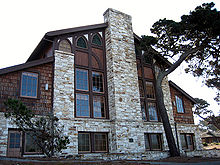
Eliza Morgan ran the household with a strong hand, giving young Julia an example of female competence and independence. In mid-1878 Eliza took the children near the Parmelees in New York for a year while Charles worked in San Francisco. In New York, Julia was introduced to her older cousin Lucy Thornton, who was married to the successful architect Pierre Le Brun. In New York, Julia contracted scarlet fever and was kept in bed for a few weeks. As a result of this illness, she was prone to ear infections throughout her adult life. After returning to Oakland, Julia kept in touch with Le Brun; he encouraged her to pursue higher education.
In July 1880, Grandfather Parmelee died. Soon, Grandmother Parmelee moved into the Oakland home, bringing the family wealth with her. This reinforced Julia's view that women were the foundation of society's resources.
Morgan resisted her mother's suggestion that she attend a debutante ball to celebrate her marriageability. She argued that she should have a career first. Her parents supported this wish.
training
Morgan graduated from Oakland High School in 1890 and enrolled at the University of California in nearby Berkeley . At university she was a member of the Kappa Alpha Theta association . After graduating, Morgan became a member of the Association of Collegiate Alumnae, now the American Association of University Women . She graduated in 1894 with a degree in civil engineering; she was the only woman in her engineering class.
One of her senior year technical instructors was Bernard Maybeck, an architect who designed buildings that Morgan admired for their respect for the surrounding topography and environment. Maybeck mentored Morgan in the architecture of his Berkeley home along with her classmates Arthur Brown, Jr., Edward H. Bennett, and Lewis P. Hobart. He encouraged Morgan to continue her studies at the prestigious École Nationale Supérieure des Beaux-Arts in Paris, where he had excelled.
Morgan gained a year of work experience in construction at Maybeck, then traveled to Paris in 1896 to prepare for the Beaux-Arts entrance examination. The school had never before allowed a woman to study architecture, but in 1897 it opened its admissions process to female applicants, largely under pressure from an association of French women artists, which Morgan described as "bohemians" . Morgan met with these women and was influenced by their feminist views; they discussed how to increase the influence of women in professional careers.
In principle, the school accepted the 30 best candidates. It took Morgan three tries to get in: on the first try she placed low, on the second try in 1898, although placing well in the top 30, the examiners lowered her grades "arbitrarily". After more than a year of further study, supervised by François-Benjamin Chaussemiche, a winner of the Prix de Rome , she finally passed the entrance exams to the architecture program, placing 13th out of 376 applicants and being duly admitted. However, she was only able to study until her 30th birthday because the school banned older students. Early in 1902, as her birthday approached, Morgan submitted an excellent design for a palace theater. This gave her an architecture diploma, making her the first woman to receive a diploma from the school; this happened in three years, although the usual study time was five years. She stayed in Paris long enough to collaborate with Chaussemiche on a project for Harriet Fearing, an ex-New Yorker who designed a "Grand Salon" for her residence in Fontainebleau .
Career
Upon her return from Paris, Morgan accepted employment with San Francisco architect John Galen Howard , who directed the University of California master plan. Morgan worked on several buildings on the Berkeley campus, providing the decorative elements for the Hearst Mining Building and an early proposal for Sather Gate . She was the principal designer of the Hearst Greek Theatre . Howard told a colleague that Morgan was "an excellent draftsman who I don't pay almost anything because he's a woman". She saved her money, made plans to work alone, and took on important side projects.
In 1904, Morgan was the first woman to receive an architectural license in California. She opened her own office in San Francisco and lived in the old family home in Oakland, where employees knew her as "JM". From 1907 to 1910 she worked with Ira Hoover, former Howard draftsman. At the end of 1910, Morgan founded his own architectural office again. She was the architect of many buildings at Mills College . Another of their earliest works was North Star House in California 's Grass Valley , commissioned in 1906 by mining engineer Arthur De Wint Foote and his wife, author and illustrator Mary Hallock Foote.
The many orders after the 1906 earthquake in San Francisco brought her financial success.
Hearst projects
The Hearst Castle facade.
Morgan's most famous patron, and thus patron, was newspaper magnate and antiques collector William Randolph Hearst , who had been introduced to Morgan by his mother, Phoebe Apperson Hearst, the main patron of the University of California, Berkeley. This introduction is believed to have led to Morgan's first downstate commission from Hearst to design the Los Angeles Examiner Building (ca. 1914), a Mission Revival style project incorporating contributions from Los Angeles architects William J. Dodd and J. Martyn contained Haenkel. It is located on the southwest corner of Broadway and 11th Streets in a neighborhood in Downtown Los Angeles , awaiting adaptive repurposing.
In 1919, Hearst chose Morgan as the architect for La Cuesta Encantada , better known as Hearst Castle , which was built on the family campground overlooking San Simeon Harbor. Morgan used tiles from California Faience , a Berkley pottery workshop, many of which she designed herself.
The project proved to be their largest and most complex, as Hearst's vision for his estate grew over the decades of planning and construction. The project included The Hacienda , a residential-private-guesthouse complex built in Mission Revival, Spanish Colonial Revival, and Moorish Revival styles. It was a day's ride inland from Hearst Castle, next to Mission San Antonio de Padua near Jolon. Her work on the Castle and San Simeon Ranch lasted until 1947, when Hearst's failing health ended.
Morgan became William Randolph Hearst's chief architect and produced the designs for dozens of buildings, such as Phoebe Apperson Hearst's Wyntoon, which he inherited. The property consists of a castle and a "Bavarian Village" with four villas, all situated on 50,000 acres of a forest reserve spanning the McCloud River near Mount Shasta in Northern California. She also worked on designs and on site for the unfinished Babicora , Hearst's 1,625,000 acre (6,580 km²) cattle rancho and retirement home in Chihuahua .
YWCA projects
Julia Morgan's interest in the YWCA began when Phoebe Apperson Hearst recommended her for the organization's Asilomar Summer Conference Center, a project she began in 1913. The Asilomar Conference Center , no longer operated by the YWCA but by the State of California, is still located in the Pacific Grove near Monterey . Morgan also designed YWCAs in California, Utah, Arizona and Hawaii.
Five of Southern California's YWCA buildings were designed by Morgan. The 1918 Harbor Area YWCA ( San Pedro , CA) in a craftsman building still stands, as does the 1926 Hollywood Studio Club YWCA. Morgan's 1929 Riverside YWCA still stands, but now serves as the Riverside Art Museum. Her 1925 Italian Renaissance branch in Long Beach was demolished. The "beautiful" Pasadena YWCA was acquired by the city for restoration and public use after several decades of decay.
She also designed YWCAs in Northern California , including those in Chinatown and Oakland in San Francisco. The YWCA building in San Francisco is currently used as a museum and home of the Chinese Historical Society of America (CHSA).
Mills College
Morgan made many architectural contributions to the Women's Mills College in the East Bay Foothills of Oakland, California. Like her work for the YWCA, they were undertaken with the hope of improving opportunities for women.
Mills President Susan Mills became interested in Morgan in 1904 because she wanted to further the career of an architect and because Morgan, who was just beginning her career, charged less than her male colleagues. Morgan designed six buildings for the Mills campus, including El Campanil , believed to be the first clock tower on a United States college campus. El Campanil should not be confused with The Campanile, a nickname for Sather Tower , the clock/bell tower of nearby University of California, Berkeley. Morgan helped design parts of the UC Berkeley campus under John Galen Howard, but Sather Tower was not her design.
Morgan's reputation grew when the tower was unscathed by the 1906 San Francisco earthquake. The bells in the tower "were cast for the World's Columbian Exposition (Chicago-1893) and presented to Susan Mills by a trustee."
Morgan also designed the Margaret Carnegie Library (1906), named after Andrew Carnegie 's daughter, and the Ming Quong Home for Chinese Girls , built in 1924 and purchased for Mills in 1936. It was eventually renamed Alderwood Hall before becoming the Julia Morgan School for Girls (independent of the college) in 2004. Morgan designed the Mills College Student Union in 1916. Morgan's Kapiolani Cottage has served as an infirmary, faculty accommodation and administrative offices. Morgan also designed the original gymnasium and pool, which has since been replaced by the Tea Shop and Suzanne Adams Plaza, the West Coast's first reinforced concrete structure .
private life
Although Morgan was highly regarded as an architect, little is known about her private life. She was never married and had no known romances. She kept a low profile and lived modestly despite her wealthy clientele. She neither gave interviews nor wrote about herself. She worked tirelessly on minimal sleep and diet. Fascinated by the gaps in Julia Morgan's life story, Belinda Taylor wrote "Becoming Julia Morgan," a 2012 play in which Taylor imagines a plausible life story for Morgan.
other projects
Morgan's other projects include the redesign of San Francisco's landmark Fairmont Hotel , which was damaged by the 1906 earthquake. She was chosen because of her knowledge of earthquake-resistant reinforced concrete structures, which was rare at the time.
She considered St. John's Presbyterian Church in Berkeley her finest Craftsman style building. It is now the Berkeley Playhouse .
Other projects include the Chapel of the Chimes (crematorium and columbarium) in Oakland, the nearby brick multi-purpose building at 4021 Piedmont Avenue, the sanctuary of Ocean Avenue Presbyterian Church at 32 Ocean Avenue, San Francisco (where Mission Bay Community Church meets) and the large Berkeley City Club adjacent to the University of California. She designed the 1918 YWCA Hostess House in Palo Alto , which would later become the home of the MacArthur Park Restaurant.
Some of their residential projects, most of them in the San Francisco Bay Area , are ultimate bungalows (large craftsman-style bungalows). The style is often associated with the work of Greene and Greene, as well as some of Morgan's other contemporaries and teachers. The buildings represent the Arts and Crafts Movement and the American Craftsman style of architecture. Several houses are located on San Francisco 's Russian Hill . She lived further west in San Francisco. In 1908, Julia Morgan designed James Henry Pierce 's San Jose residence , made of rare California wood. Another residence, known as the Julia Morgan House, built for a wealthy client is in Sacramento .
honors
Julia Morgan is buried in Mountain View Cemetery in the Oakland Hills .
California Governor Arnold Schwarzenegger and First Lady Maria Shriver announced on May 28, 2008 that Julia Morgan would be inducted into the California Hall of Fame , located at the California Museum for History, Women and the Arts. The induction ceremony took place on December 15, and her great-niece accepted the honors in her stead.
The Julia Morgan Ballroom in the Merchants Exchange Building in San Francisco, where she had her offices from 1904 to 1950, is named in her honor.
Julia Morgan became the first woman to posthumously receive the American Institute of Architects Gold Medal in 2014 . She is the first architect to receive this award.
In 2006, a children's picture book titled Julia Morgan Built a Castle was released.
literature
- Boutelle, Sara Holmes (1988). Julia Morgan, Architect. New York: Abbeville Press.
- Anna Lewis: Women of Steel and Stone . 22 Inspirational Architects, Engineers, and Landscape Designers. Chicago Review Press, Inc, Chicago 2014, ISBN 978-1-61374-511-3 .
- Morgan, J. (1976). Architectural drawings by Julia Morgan: beau-arts assignments and other buildings . Oakland, Calif.: Oakland Museum, Art Dept.
- Morgan, J., Hearst, WR, & Loe, NE (1987). San Simeon revisited: the correspondence between architect Julia Morgan and William Randolph Hearst . San Luis Obispo, Calif.: Library Associates, California Polytechnic State University.
- Morgan J (1987). Berkeley houses by Julia Morgan . Berkeley, California: The Association.
web links
- Morgan (Julia) Papers, 1835-1958 (bulk 1896-1945) Kennedy Library - Home. In: lib.calpoly.edu. Retrieved December 29, 2018 (English).
- Julia Morgan—An Online Exhibition Kennedy Library—Home. In: lib.calpoly.edu. Retrieved December 29, 2018 (English).
- Morgan, Julia - CED Archives. In: archives.ced.berkeley.edu. Retrieved December 29, 2018 (English).
- Julia Morgan: Hidden Engineer · Environmental Design Archives Exhibitions. In: exhibits.ced.berkeley.edu. Retrieved December 29, 2018 (English).
- Guide to the Julia Morgan Architectural Drawings, 1907-1929. In: oac.cdlib.org. August 1, 2016, accessed December 29, 2018 (English).
- Index of Buildings by Julia Morgan. In: bluffton.edu. Retrieved December 29, 2018 (English).
- Julia Morgan. In: The Beverly Willis Architecture Foundation. Retrieved December 29, 2018 (English).
- One Woman's Contribution to Arts and Crafts Architect ( Memento of 12 May 2015 at the Internet Archive )
- Nancy Mitchell: Julia Morgan SPOTLIGHT ON WOMEN IN DESIGN. In: apartment therapy. 18 September 2012, accessed 29 December 2018 (English).
- Julia Morgan 2012
- Morgan (Julia) Collection, 1893-1980. In: calisphere.org. Retrieved December 29, 2018 (English).
- Julia Morgan. In: arch INFORM .
itemizations
- ↑ a b AGORHA : Bases de données de l'Institut national d'histoire de l'art (INHA). In: agorha.inha.fr. Retrieved December 30, 2018 (French).
- ↑ a b Julia Morgan was a local - The New Fillmore. In: newfillmore.com. February 1, 2011, accessed December 30, 2018 (English).
- ↑ Kevin Starr: The dream endures . California enters the 1940s. Oxford University Press, New York 1997, ISBN 978-0-19-515797-0 .
- ↑ a b Karissa Rosenfield: Julia Morgan Awarded 2014 AIA Gold Medal - ArchDaily. In: archdaily.com. December 12, 2013, retrieved December 30, 2018 (English).
- ↑ Harriet Rochlin: Designed by Julia Morgan . Ed.: Automobile Club of Southern California. volume, no. 68 , p. 26-29, 75-76, 80 (English).
- ↑ a b Ginger Wadsworth: Julia Morgan, Architect of Dreams . Twenty-First Century Books, Minneapolis, Minnesota 1990, ISBN 978-0-8225-4903-1 , pp. 128 ( limited preview in Google Book Search).
- ↑ a b c d e Karen McNeill: Women Who Buid . Julia Morgan & Women's Institutions. Ed.: California Historical Society. volume, no. 89 , p. 41–74 (English, californiahistoricalsociety.org [PDF] Original title: "Women Who Buid" Julia Morgan & Women's Institutions . 2012.).
- ↑ a b c Mark Wilson: Julia Morgan: Architect of Beauty . Gibbs Smith, Layton, Utah 2007, ISBN 978-1-4236-0088-6 , pp. 3-5 .
- ↑ Maggie Reichers: Beyond San Simeon . In: Neh.gov (ed.): Humanities . tape 27 , No. 5 , 2007 (English, neh.gov [Accessed 7 September 2012] Original title: Beyond San Simeon .).
- ↑ Julia Morgan: Early Architect. California State Capitol website . Archived from the original on June 23, 2007. Retrieved May 26, 2009., Retrieved 2009-05-26
- ↑ a b Sara Holmes Boutelle: Julia Morgan, Engineer and Architect . In: Old House Journal . tape 24 , no. 2 . Active Interest Media, 1996, ISSN 0094-0178 (English, limited preview in Google Book Search).
- ↑ Ed Herny, Shelley Rideout, Katie Wadell: Berkeley Bohemia . Artists and Visionaries of the Early 20th Century. Gibbs Smith Publishers, Layton, Utah 2008, ISBN 978-1-4236-0085-5 (English).
- ↑ Julia Morgan Papers. In: Julia Morgan Papers, Special Collections, California Polytechnic State University, San Luis Obispo. Robert E. Kennedy Library, California Polytechnic State University, 2007, accessed December 30, 2018 .
- ↑ a b Floyd B. Bariscale: No. 186 - Morgan House (Harbor Area YWCA) . In: Big Orange Landmarks . October 1, 2008. Retrieved May 11, 2010.
- ↑ a b c d e f g h Susan Ito: Julia Morgan at Mills (PDF). In: Mills Quarterly , Mills College, Winter 2004, p. 14. Retrieved 27 February 2008.
- ↑ a b c d Mills College 2007/2008 Undergraduate Student Handbook (PDF), School Datebooks, 2007 (Accessed 27 February 2008).
- ↑ Erica Reder, "Belinda Taylor presents: Becoming Julia Morgan" , in the Landmarks of California , 2012
- ↑ "An Architect from the Inside Out ," Los Angeles Times, September 4, 1988
- ↑ Berkeley Landmarks : St. John's Presbyterian Church. In: berkeleyheritage.com. May 15, 1907, retrieved January 1, 2019 .
- ↑ MacArthur Park. In: macpark.com. Retrieved January 1, 2019 .
- ↑ San Jose's Julia Morgan House . In: Continuity . Summer 2009.
- ↑ Memorials: Julia Morgan (1872-1957) - Find A Grave Memorial. In: www.findagrave.com. May 28, 2008, accessed January 1, 2019 (English).
- ↑ Governor & First Lady Participate in 2008 CA Hall of Fame Induction Ceremony . State of California, Office of Governors. Archived from the original on June 2, 2015. Info: The archive link was inserted automatically and has not yet been checked. Please check the original and archive link according to the instructions and then remove this notice. Retrieved May 20, 2013.
- ↑ About the Historic Julia Morgan Ballroom Event Space in San Francisco. In: juliamorganballroom.com. October 7, 2001, accessed January 1, 2019 (English).
- ↑ Celeste Mannis: Julia Morgan Built a Castle . Viking Juvenile, New York City 2006, ISBN 978-0-670-05964-5 (English).
| personal data | |
|---|---|
| SURNAME | Morgan, Julia |
| BRIEF DESCRIPTION | American architect |
| BIRTH DATE | January 20, 1872 |
| PLACE OF BIRTH | San Francisco , California |
| DATE OF DEATH | February 2, 1957 |
| PLACE OF DEATH | San Francisco , California |

